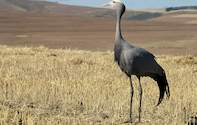
South Africa's national bird, the blue crane, is facing the threat of extinction due to death by power line collisions and a loss of habitat. The bird is largely endemic to South Africa, with only a small population of about 60 - 80 individuals residing in the Etosha Pan in Namibia.
In 2014, the Western Cape saw the start of numerous wind warms, which researchers predict will have a negative impact on the existing blue crane populations. Genevieve Jones, who manages research for the African Crane Conservation Programme of the Endangered Wildlife Trust (EWT), said that along with the increase in power lines comes an increased mortality rate. "We know the Western Cape is a hot spot for wind turbines and these will, unfortunately, have a negative impact on the birds", she said.
The Endangered Wildlife Trust's South African Crane Working Group (EWT-SACWG) fitted satellite transmitters to five blue cranes in the Karoo from March 8 to 11, 2008. The data received from these transmitters has helped the EWT-SACWG to better understand the movements of South Africa's national bird, information that is vital for successful management and conservation of the species. The team took advantage of the cranes' moulting season to carry out the satellite fittings, as these large birds are flightless during this time and therefore far easier to catch.
The satellite trackers were fitted to a harness, attached just behind the birds' shoulders by sewing straps to each other with dental floss. Past experience has shown that the dental floss will degrade in approximately two years, at which time enough data will have been collected, and the harness and the transmitter will fall off.
The trackers will obtain global GPS coordinates via satellite twice a day and store this information. When the birds move within range of a cell phone tower, the data will be downloaded and automatically e-mailed to a website managed by YRless Tracking Solutions, where the data will be kept and analysed. The devices are relatively small, approximately 5x3cm, lightweight, and are well within the recommended weight for migrating birds, namely less than 10 percent of the bird's bodyweight.
The five cranes were also each fitted with a unique colour ring combination on their legs to make it easier to identify them in future. Each crane had a red over white combination on one leg, above the knee, to identify them as birds that were ringed in the Northern Cape, and a unique combination of three coloured rings on the other leg to identify the individual bird.
The colour combinations were determined by the EWT-SACWG, and each bird also received a uniquely numbered metal ring from Safring, the national body responsible for administering bird ringing in southern Africa.
Blue cranes are partial migrants, travelling from their breeding grounds at the end of summer to join other flocks for the duration of winter. These combined flocks can reach numbers of up to 300 before the breeding pairs once again split from the non-breeding flock at the beginning of spring,
Knowing where the cranes move to in winter, and understanding their dispersal to breeding areas, is vital for the successful blue crane conservation. While biologists have some idea of these movements through observation, no scientific evidence has yet been gained.
The satellite fittings were done on three farms in the Richmond and Philipstown districts of the Northern Cape, with a team consisting of four people from the EWT-SACWG. The team was assisted by farmers and farm workers from the area. "Most farmers in this area are always available to assist where extra manpower is needed, and the EWT-SACWG would be unable to perform its duties without their support. On this particular occasion the farmers provided extra transportation in the form of field motorbikes for easier access to areas where the cranes were present," said Hélen Prinsloo, coordinator of EWT-SACWG.
This project forms part of a nationwide research project that is funded by the Darwin Initiative, a grant scheme initiated by the United Kingdom government to promote biodiversity and sustainable use of resources. The work is conducted by EWT-SACWG in collaboration with scientists from the Zoological Society of London. Results from the current research will contribute crucial data in order to identify priority focus areas for future conservation of blue cranes.
Reference
IOL Scitechhttps://www.iol.co.za/scitech/science/environment/loss-of-grassland-hits-the-blue-crane-1.1713195#.VC1NW_mSwwA

